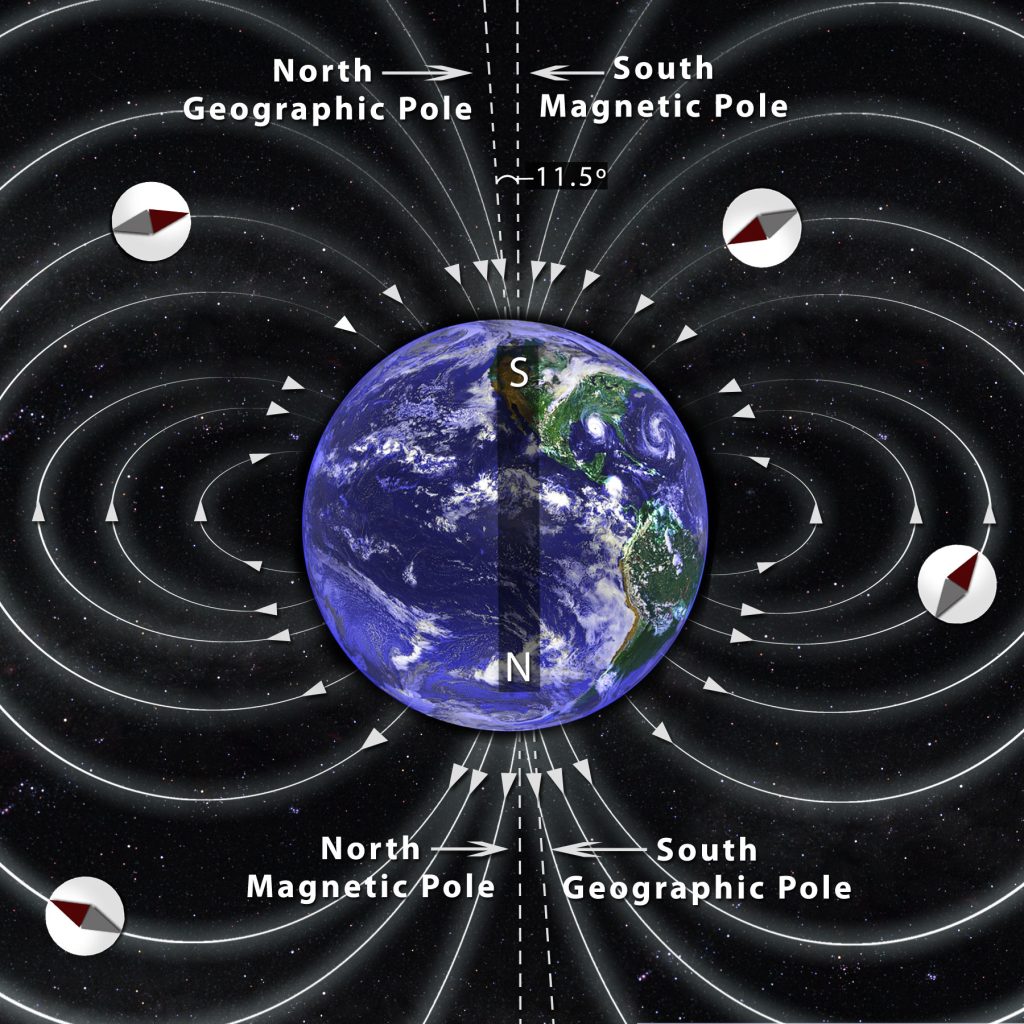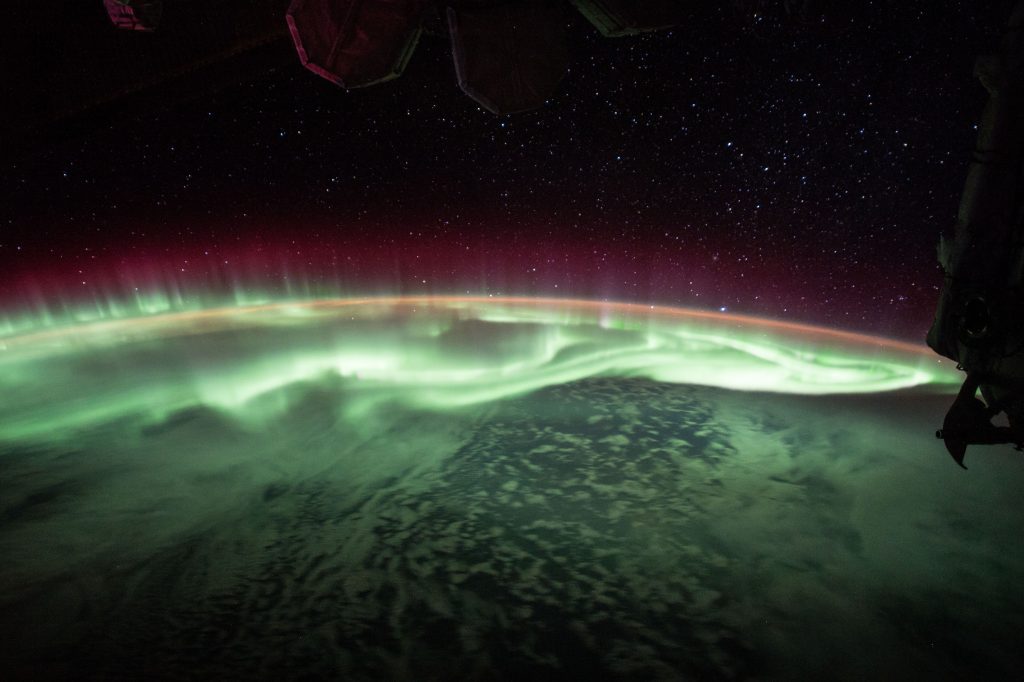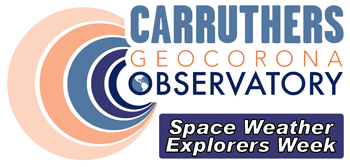Space weather
The interaction between the solar wind and Earth is dynamic and generates several phenomena collectively called space weather. The solar wind also interacts with other bodies in the Solar System and scientists are eager to understand and predict all of these interactions. As our modern civilization relies more and more on large electrical grids on Earth and satellite communications in space, we experience more of the effects of space weather.
Magnetosphere
Earth’s magnetic field is generated by electrical currents in its molten iron core. The shape of the magnetic field is similar to that of a bar magnet, with the magnetic poles closely aligned to the spin axis of the planet. The field strength weakens with distance from the core.
Out in space, Earth’s magnetic field encounters the solar wind. The solar wind is made of hot, electrically charged particles from the Sun’s atmosphere, at very low density (about 1 proton per cubic centimeter). The solar wind flows by Earth with a typical speed of a few hundred kilometers per second. It carries with it the magnetic field of the Sun.
Electric and magnetic forces are deeply connected to each other. Magnetic forces are created by the movement of electric charges. Electric charges are deflected when they encounter magnetic forces.
When the charged particles in the solar wind encounter Earth’s magnetic field, they are deflected around it. Earth’s magnetic field acts like a shield. But the energy of that interaction as the solar wind flows around Earth, distorts the magnetic field. The field is compressed where the wind collides with it, the side of Earth facing the Sun, the dayside. The field is then drawn out into a long tail downstream of the solar wind, on the side of Earth facing away from the Sun, the nightside.
For the most part, solar wind particles do not get inside this magnetosphere. A small fraction can leak into it from the magnetotail. And some particles are directed along the magnetic field poles, in a funnel shape, right into Earth’s atmosphere. These are called the cusps of the magnetosphere and there is a kind of aurora generated by these direct impacts: cusp aurorae. They can be observed by spacecraft, but are usually difficult to see from the ground as they typically occur on the day side of Earth, when the daytime sky is too bright for the much dimmer cusp aurorae to be seen. The particles that create the normal aurorae are not from the solar wind, but from Earth’s own atmosphere.
Any changes in the solar wind speed, density, or magnetic field direction and strength will ripple through the magnetosphere.
Solar Flares
When solar flares erupt on the Sun they blast the Earth with high energy light in the form of x-rays, and occasionally gamma-rays from the most extreme events. This electromagnetic radiation passes right through Earth’s magnetosphere and is absorbed by our atmosphere. It strips electrons off of atoms and molecules in the top layers of Earth’s atmosphere. This enhances the ionosphere and can create a splash of high energy charged particles into low-Earth orbit. These extra charged particles can damage the electronic equipment aboard spacecraft. This energy also heats the outer layers of the atmosphere, causing it to puff up, which increases the density of air at higher altitudes. This can create additional drag on satellites orbiting Earth, slowing them down and altering their trajectories. This can be dangerous, as it can make it very difficult to predict when a satellite’s orbit could decay enough to re-enter the atmosphere, and fall back to Earth.
Geomagnetic Storms
Solar System Impacts
Other bodies in the Solar System also interact with the solar wind and experience their own versions of space weather.
Small bodies like the Moon or Mercury, which have no atmosphere, receive the full spectrum of the Sun’s electromagnetic radiation at their surface, which ionizes much of the surface rock and dust. Mercury has a magnetic field that deflects most of the solar wind but the Moon does not and therefore the surface of the Moon also gets bombarded with solar wind particles. The surface dust of the Moon can become so charged up that electrical repulsion creates clouds of levitating lunar dust on the surface.
Venus has no magnetic field, and so its atmosphere directly interacts with the solar wind. The day side of Venus’s atmosphere has a strong and thick ionosphere resulting from this that then pushes the bulk of the solar wind flow away through electrostatic repulsion.
Mars also has no global magnetic field, though it appears to have had one billions of years ago that must have gone away as its core cooled. With the loss of the magnetic field, Mars’ atmosphere has been directly impacted by the solar wind, which has stripped much of it away. The loss of atmospheric pressure from solar wind stripping was probably a leading cause of the loss of Mars’ oceans.
The giant planets (Jupiter, Saturn, Uranus, and Neptune) all have very strong magnetospheres generated by interior oceans of hydrogen compounds in a superconducting metallic state. They each experience auroras and magnetic storms as the solar wind flows around them. The most intense auroras in the Solar System occur on Jupiter.
Asteroids and comets also interact with the solar wind which can alter their surface chemistry and electrical properties. In the case of comets, when they come close enough to the Sun, ices on their surface evaporate creating an extended atmosphere of dust and gas called a coma. Much of that gas is ionized by solar radiation, and the solar wind drags that gas out into a long tail that can be seen all around the inner Solar System. The pressure from the Sun’s light actually pushes the comet’s dust away into a second tail. Comets usually have two tails: a dust tail pushed back by solar radiation; and an ion tail pushed back by the solar wind.
This solar influence extends far beyond the planets, into a region a hundred times farther away from the Sun than the Earth. In this region, the solar wind merges with the matter that exists between the stars. Everything inside this enormous bubble is called the Heliosphere. It gets its name from a character in Greek traditions, Helios, a god who pulled the Sun across the sky in a horse-drawn chariot.
Activities
Hands-On




